Abstract
BACKGROUND--A study was conducted to find out if pre-employment lung function at age 16 improved the estimation of that between ages 25 to 27 compared with the use of reference values based on smoking history, stature, body mass index, and other concurrent anthropometric variables. METHODS--Apprentices attending a shipyard training school were assessed on six occasions from entry during their 17th year to age 25 to 27; results for 114 such men were analysed. The measurements were of stature, body mass, fat free mass and body fat, thoracic dimensions, forced expiratory volume and indices of forced expiratory flow, total lung capacity, and its subdivisions, transfer factor and KCO. RESULTS--At best about half the variance in the final lung function could be accounted for with the concurrent reference variables. For each lung function index the proportion of explained variance was substantially increased by also including in the prediction equation the pre-employment lung function expressed in standard deviation units. CONCLUSION--Estimation of the longitudinal decline in lung function during adult life should be based on initial and final measurements of which the first should ideally be at age 25 but those at age 16 can be used instead: such measurements have long term value and should be preserved.
Full text
PDF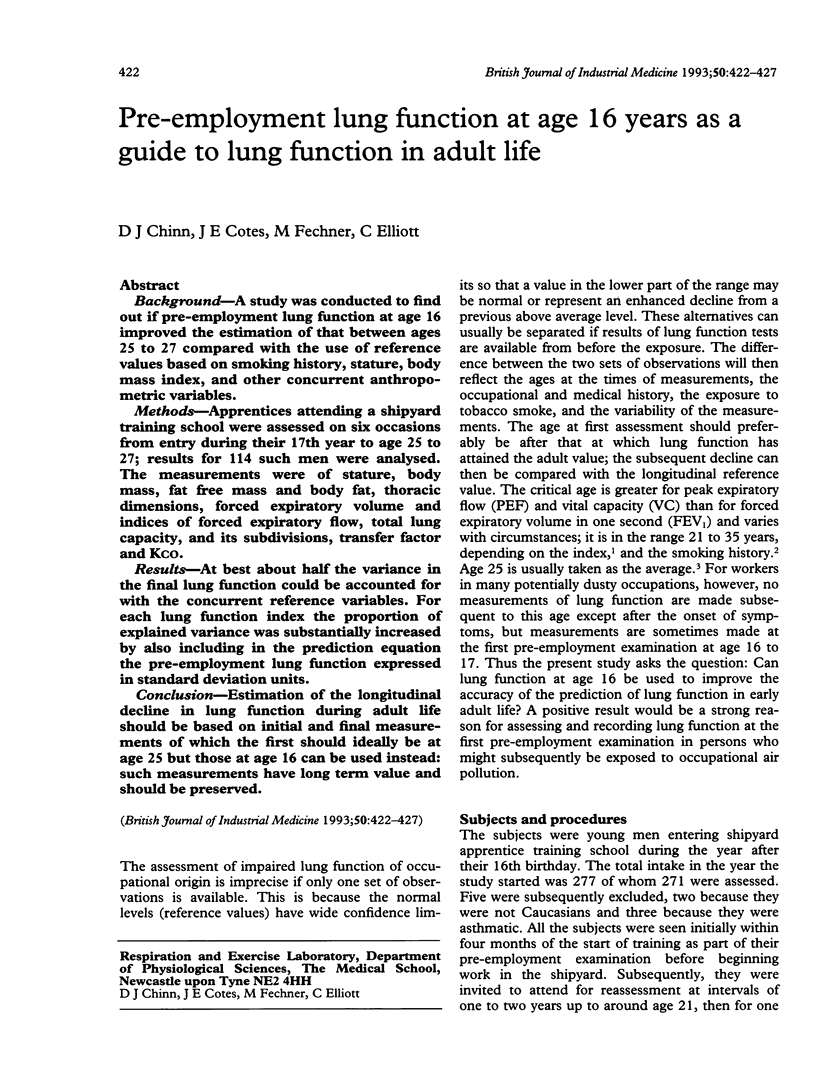
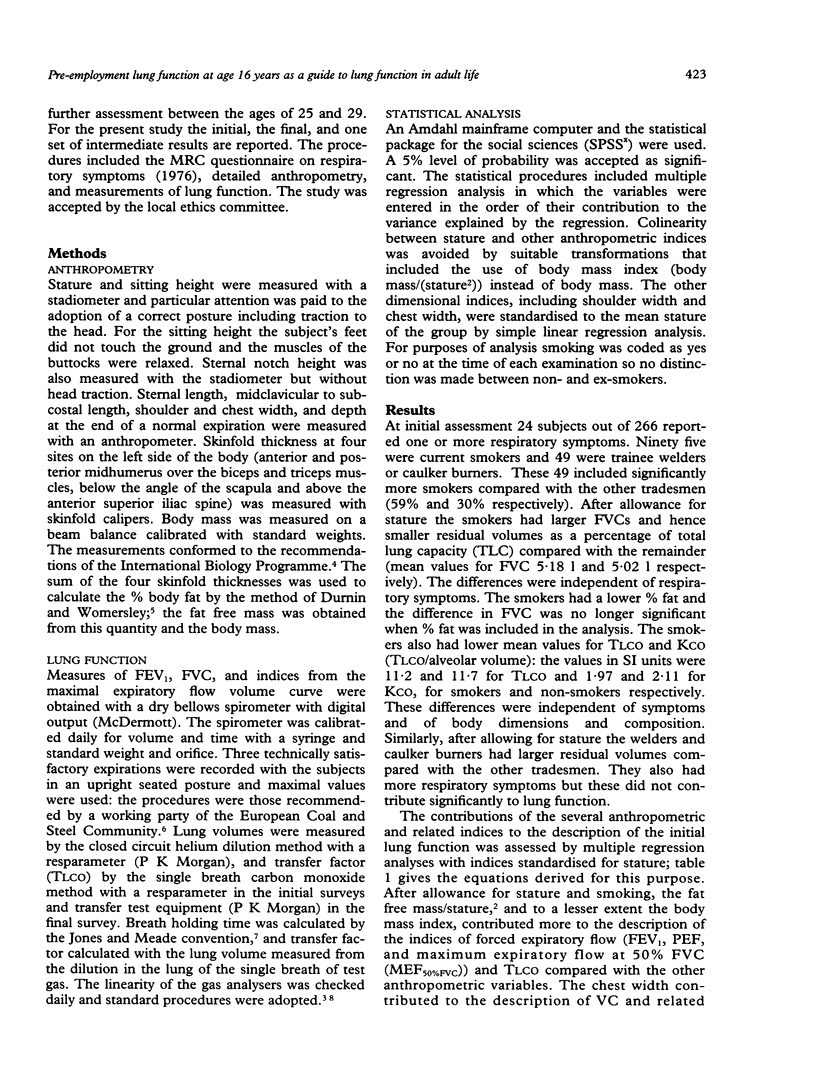
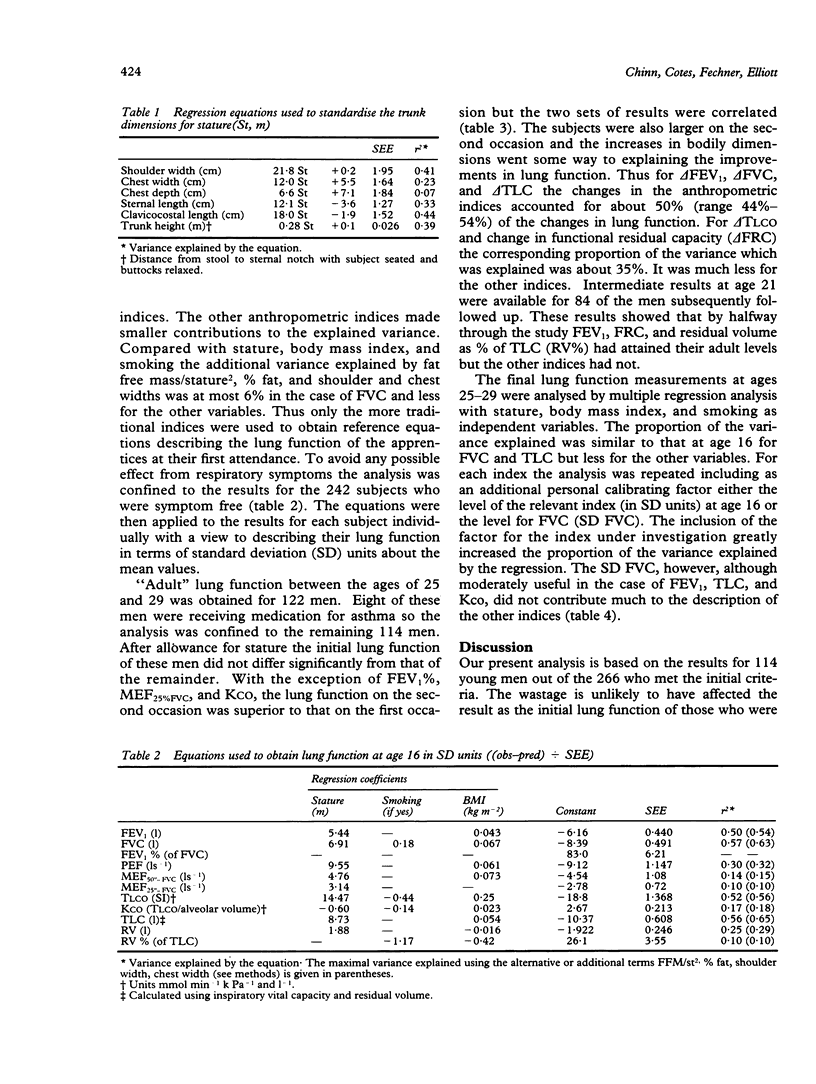
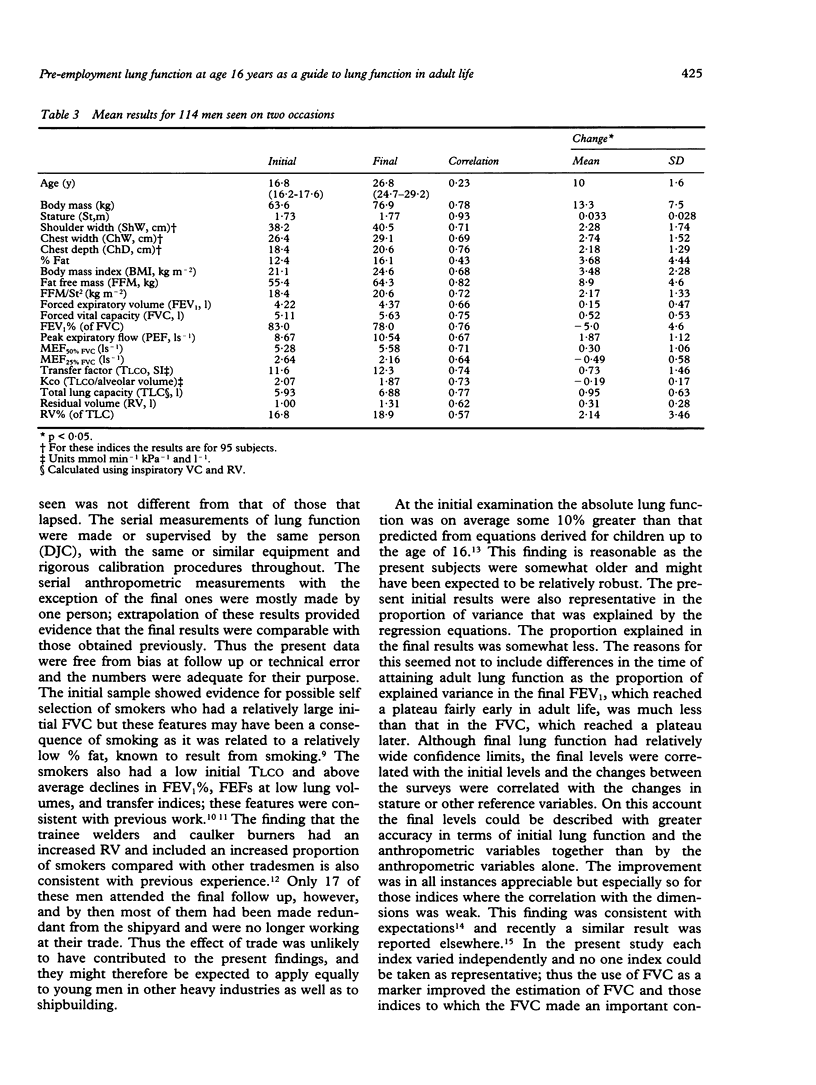
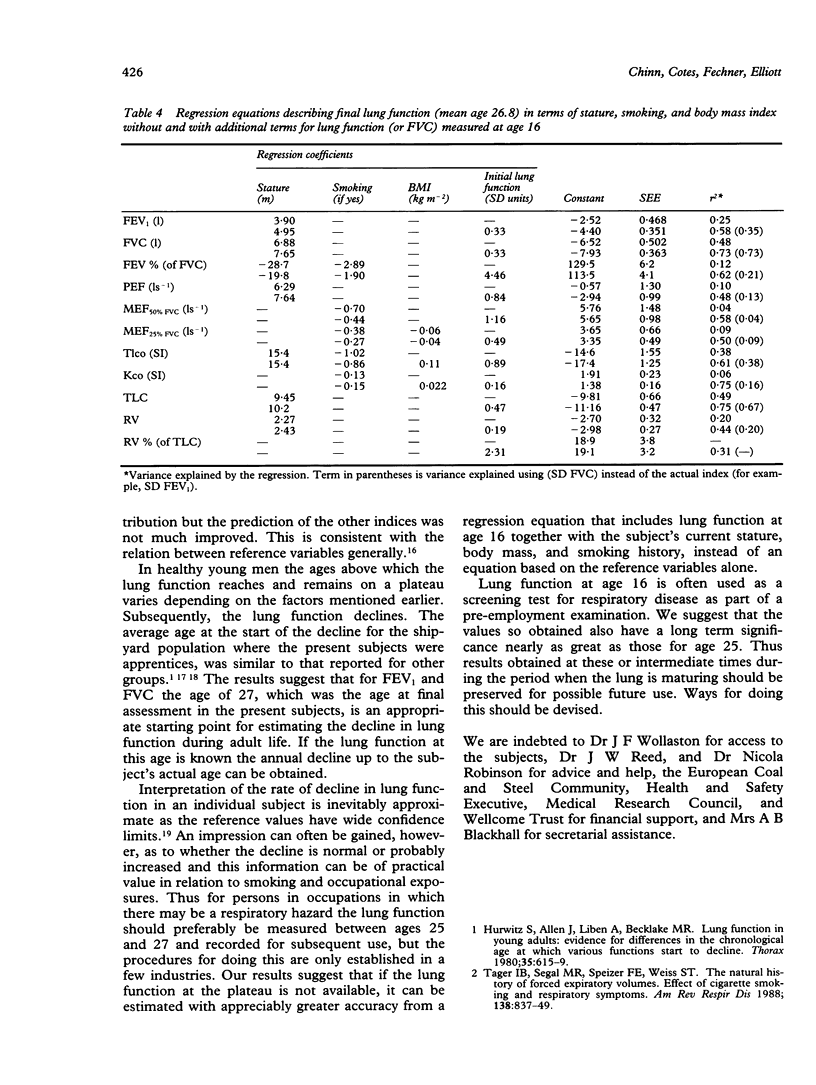
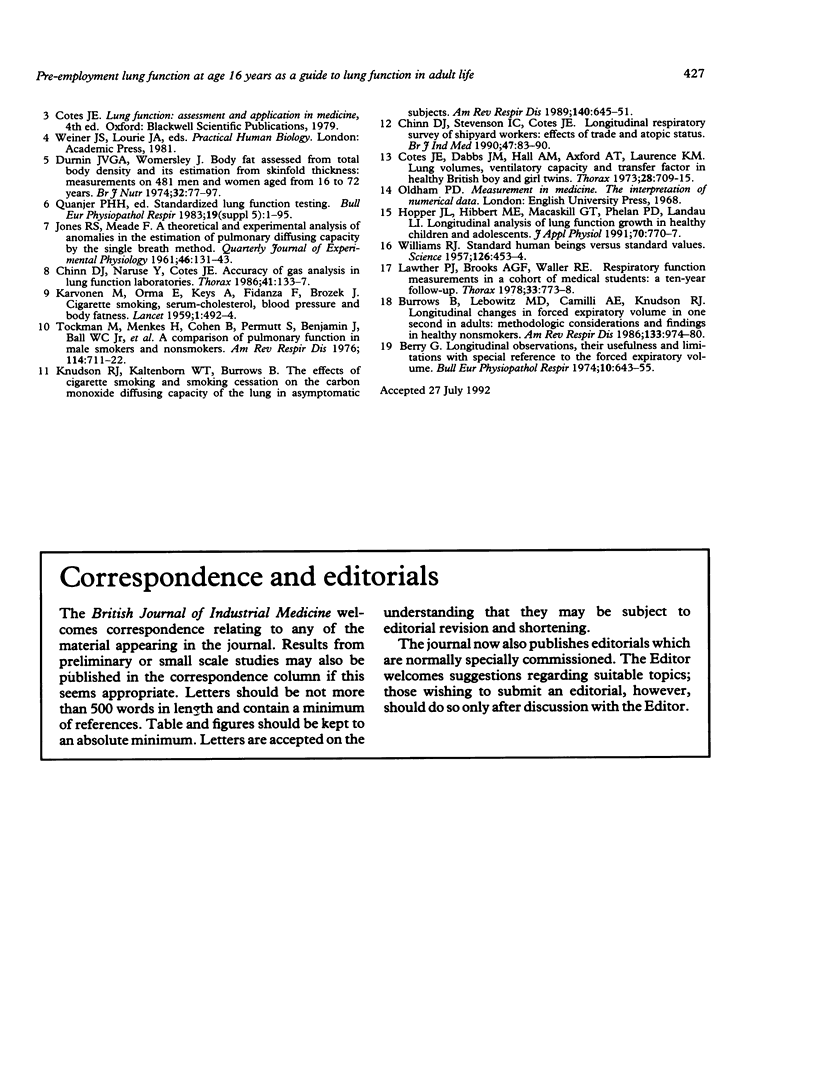
Selected References
These references are in PubMed. This may not be the complete list of references from this article.
- Berry G. Longitudinal observations. Their usefulness and limitations with special reference to the forced expiratory volume. Bull Physiopathol Respir (Nancy) 1974 Sep-Oct;10(5):643–656. [PubMed] [Google Scholar]
- Burrows B., Lebowitz M. D., Camilli A. E., Knudson R. J. Longitudinal changes in forced expiratory volume in one second in adults. Methodologic considerations and findings in healthy nonsmokers. Am Rev Respir Dis. 1986 Jun;133(6):974–980. doi: 10.1164/arrd.1986.133.6.974. [DOI] [PubMed] [Google Scholar]
- Chinn D. J., Naruse Y., Cotes J. E. Accuracy of gas analysis in lung function laboratories. Thorax. 1986 Feb;41(2):133–137. doi: 10.1136/thx.41.2.133. [DOI] [PMC free article] [PubMed] [Google Scholar]
- Chinn D. J., Stevenson I. C., Cotes J. E. Longitudinal respiratory survey of shipyard workers: effects of trade and atopic status. Br J Ind Med. 1990 Feb;47(2):83–90. doi: 10.1136/oem.47.2.83. [DOI] [PMC free article] [PubMed] [Google Scholar]
- Cotes J. E., Dabbs J. M., Hall A. M., Axford A. T., Laurence K. M. Lung volumes, ventilatory capacity, and transfer factor in healthy British boy and girl twins. Thorax. 1973 Nov;28(6):709–715. doi: 10.1136/thx.28.6.709. [DOI] [PMC free article] [PubMed] [Google Scholar]
- Durnin J. V., Womersley J. Body fat assessed from total body density and its estimation from skinfold thickness: measurements on 481 men and women aged from 16 to 72 years. Br J Nutr. 1974 Jul;32(1):77–97. doi: 10.1079/bjn19740060. [DOI] [PubMed] [Google Scholar]
- Hopper J. L., Hibbert M. E., Macaskill G. T., Phelan P. D., Landau L. I. Longitudinal analysis of lung function growth in healthy children and adolescents. J Appl Physiol (1985) 1991 Feb;70(2):770–777. doi: 10.1152/jappl.1991.70.2.770. [DOI] [PubMed] [Google Scholar]
- Hurwitz S., Allen J., Liben A., Becklake M. R. Lung function in young adults: evidence for differences in the chronological age at which various functions start to decline. Thorax. 1980 Aug;35(8):615–619. doi: 10.1136/thx.35.8.615. [DOI] [PMC free article] [PubMed] [Google Scholar]
- JONES R. S., MEADE F. A theoretical and experimental analysis of anomalies in the estimation of pulmonary diffusing capacity by the single breath method. Q J Exp Physiol Cogn Med Sci. 1961 Apr;46:131–143. doi: 10.1113/expphysiol.1961.sp001525. [DOI] [PubMed] [Google Scholar]
- KARVONEN M., ORMA E., KEYS A., FIDANZA F., BROZEK J. Cigarette smoking, serum-cholesterol, blood-pressure, and body fatness; observations in Finland. Lancet. 1959 Mar 7;1(7071):492–494. doi: 10.1016/s0140-6736(59)91022-0. [DOI] [PubMed] [Google Scholar]
- Knudson R. J., Kaltenborn W. T., Burrows B. The effects of cigarette smoking and smoking cessation on the carbon monoxide diffusing capacity of the lung in asymptomatic subjects. Am Rev Respir Dis. 1989 Sep;140(3):645–651. doi: 10.1164/ajrccm/140.3.645. [DOI] [PubMed] [Google Scholar]
- Lawther P. J., Brooks A. G., Waller R. E. Respiratory function measurements in a cohort of medical students: a ten-year follow-up. Thorax. 1978 Dec;33(6):773–778. doi: 10.1136/thx.33.6.773. [DOI] [PMC free article] [PubMed] [Google Scholar]
- Tager I. B., Segal M. R., Speizer F. E., Weiss S. T. The natural history of forced expiratory volumes. Effect of cigarette smoking and respiratory symptoms. Am Rev Respir Dis. 1988 Oct;138(4):837–849. doi: 10.1164/ajrccm/138.4.837. [DOI] [PubMed] [Google Scholar]
- Tockman M., Menkes H., Cohen B., Permutt S., Benjamin J., Ball W. C., Jr, Tonascia J. A comparison of pulmonary function in male smokers and nonsmokers. Am Rev Respir Dis. 1976 Oct;114(4):711–722. doi: 10.1164/arrd.1976.114.4.711. [DOI] [PubMed] [Google Scholar]
- WILLIAMS R. J. Standard human beings versus standard values. Science. 1957 Sep 6;126(3271):453–454. doi: 10.1126/science.126.3271.453-a. [DOI] [PubMed] [Google Scholar]


